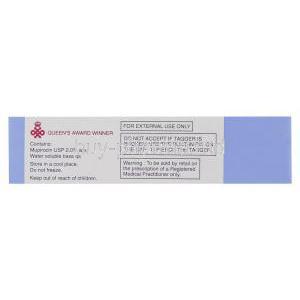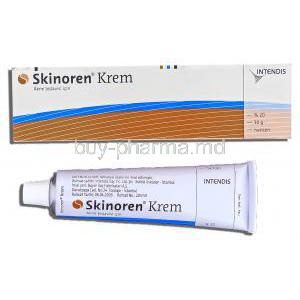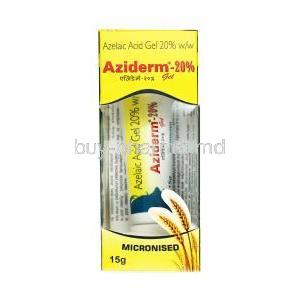Acnelyse Cream, Retinoic Acid
- What is Acnelyse Cream
- Composition of Acnelyse Cream
- Uses of Acnelyse Cream
- Off-Label Uses of Acnelyse Cream
- How Acnelyse Cream Works
- Dosage and Administration
- Side Effects of Acnelyse Cream
- Serious Side Effects and Adverse Reactions
- Interactions with Acnelyse Cream
- Contraindications for Using Acnelyse Cream
- Precautions When Using Acnelyse Cream
- Special Considerations
- Overdose and Management
- Storage and Handling Precautions
- Conclusion and Summary
What is Acnelyse Cream
Overview of Acnelyse Cream
Acnelyse Cream is well known in dermatology for its effectiveness in treating various skin issues, especially acne. Its exfoliating ingredients help speed up the skin cell renewal process, leading to a decrease in acne spots and a more even skin texture. This topical treatment plays a role in managing acne and dealing with issues like hyperpigmentation and uneven skin tone.

Historical Development and Approval
The origins of Acnelyse Cream can be traced back to the 20th century when there was a surge in dermatological research, particularly on retinoids. Its approval marked an achievement in dermatology supported by thorough clinical trials that demonstrated its effectiveness and safety. Acnelyse Cream has been improved through formulations to enhance its effectiveness and reduce potential side effects.
Composition of Acnelyse Cream
Active Ingredients and Their Concentrations
- Tretinoin is commonly known as the active ingredient, usually found in concentrations between 0.025% and 0.1%. It is well known for its effects on cell renewal and its ability to regulate keratinization.
- Hydroquinone, often included at levels between 2% and 4%, acts as a skin-brightening agent by reducing hyperpigmentation by inhibiting melanin production.

Inactive Ingredients and Their Roles
In addition to the components, Acnelyse Cream also contains various inactive elements that support the formulation and improve skin compatibility:
- Moisturizers: Ingredients like mineral oil or lanolin work to hydrate and soften the skin, counteracting any dryness caused by the active ingredients.
- Preservatives: Components such as parabens or phenoxyethanol are included to prevent the growth of microbes, thereby prolonging the product's shelf life.
- Stabilizers: Compounds, like edetate disodium, help maintain the stability of active ingredients, especially under different storage conditions.
Uses of Acnelyse Cream
Primary Indications: Acne Spot Treatment
Acnelyse Cream is mainly used as a remedy for acne. It utilizes its powerful ingredients to reduce and heal acne spots. It addresses breakouts by speeding up cell regeneration and decreasing inflammation.
Effectiveness for Primary Conditions
The formulation's effectiveness goes beyond treating acne. Numerous clinical studies have shown that it can improve skin texture and tone, which is why it is widely used in dermatological treatments.
Retinoic Acid for Hair Growth
Studies have shown that retinoic acid, a key component of Acnelyse Cream, may positively affect hair growth. It is believed to stimulate epithelial cells, creating a favorable setting for hair regeneration.
Retinoic Acid Receptor
Retinoic acid works by attaching to nuclear receptors found in skin cells called retinoic acid receptors (RARs). These receptors play a role in transmitting signals that control gene expression, affecting cell growth and development.
Retinoic Acid Signaling
The way retinoic acid works is crucial for its effects on the skin. It mainly affects how genes that control cell growth and specialization are read, essential for treating skin conditions and improving the renewal of the skin layer.
Retinoic Acid Pathway
This process in biochemistry includes transforming vitamin A derivatives into acid, which plays a crucial role in signaling within cells vital for maintaining skin health and promoting renewal.
Retinoic Acid Derivatives
Acnelyse Cream might include variations of acid, which are altered versions crafted to improve absorption and reduce irritation, ultimately improving the effectiveness of skin treatments.
Baby Acne vs Eczema
- Baby acne usually appears as red bumps, mainly on the face, due to hormones passed from the mother.
- Conversely, eczema is identified by itchy, irritated skin patches that can be more widespread and not necessarily linked to hormonal factors.
Fungal acne vs Hormonal Acne
Fungal acne occurs when there is an excess of yeast in the hair follicles, resulting in pimples. In contrast, hormonal acne is linked to changes and manifests as more profound, agonizing cysts or nodules.
Retinoic Acid vs Tretinoin
Retinoic acid, the form of vitamin A directly impacting cellular processes, differs from tretinoin, its precursor. Tretinoin needs to convert the skin to become active, which affects its effectiveness and potential side effects.
Retinoic Acid vs Retinol
Retinol, a form of vitamin A, is gentler than acid. When applied to the skin, it transforms into acid at a slower pace, resulting in lesser irritation and possibly slower results.
Off-Label Uses of Acnelyse Cream
Overview of Common Off-Label Applications
Acnelyse Cream is widely known for its effectiveness in treating acne. It is also used for various other purposes beyond its primary use. Dermatologists frequently recommend it for issues like photoaging and keratosis pilaris and as a supplement in skin rejuvenation treatments. While not formally approved for these uses, its benefits stem from its ability to promote skin cell renewal and regeneration.
Evidence Supporting Off-Label Uses
These standard uses are supported by real-world research and firsthand accounts from medical professionals. Research has shown that the key components in Acnelyse Cream can effectively improve signs of aging skin, such as wrinkles and uneven texture, which in turn helps expand its use in dermatology.
How Acnelyse Cream Works
Mechanism of Action in Acne Treatment
Acnelyse Cream improves acne by regulating the growth of skin cells. Its key ingredient, a potent retinoid, helps maintain normal skin cell shedding, prevents pore blockages, and minimizes the development of comedones. Additionally, this compound is effective in reducing skin inflammation.

Impact on Skin at the Cellular Level
At the level, the Acnelyse Cream works in various ways:
- It speeds up the renewal of cells helping to get rid of old skin cells and allowing new healthier ones to surface.
- It regulates the activity of genes related to cell development and inflammation, which are important for keeping the skin balanced.
- The ingredients reach into the skin layers, where they can directly impact the cells responsible for maintaining skin health and integrity.
Dosage and Administration
Recommended Dosages for Various Conditions
The right amount of Acnelyse Cream can differ based on the addressed condition. Typically, for mild to moderate acne, applying a thin layer once a day in the evening is common. In cases of severe acne or other skin issues, such as photoaging, the dermatologist may recommend adjusting the frequency and amount of application after evaluating your skin.
Application Techniques for Optimal Results
For results, apply acne cream to clean dry skin. A small amount the size of a pea is suitable for the face. Make sure to spread it, avoiding the areas around your eyes, nostrils, and mouth. Since retinoids may cause dryness, following up with a comedogenic moisturizer is suggested.

How to Remove Acne Scars Naturally in a Week
- Try this remedy for scars: Combine honey and fresh lemon juice to lighten and heal scars.
- You can also use aloe vera gel to soothe your skin and promote cell regeneration.
- Another option is to apply vitamin E oil on the scars, as it has antioxidant properties that aid healing.

How to Get Rid of Butt Acne
Dealing with butt acne requires keeping things clean using products that won't clog pores and applying treatments like benzoyl peroxide or salicylic acid. Keeping the skin dry and wearing clothes to avoid breakouts is also helpful.
Side Effects of Acnelyse Cream
Common Side Effects: List and Description
- Redness and peeling may occur as your skin adapts to the treatment.
- Awareness of increased sensitivity to sunlight is essential, as retinoids can make your skin more prone to UV damage.
- Dryness and irritation are common in the first few weeks of treatment. Remember to use a broad-spectrum sunscreen while undergoing therapy.
https://www.medicinesfaq.com/brand/acnelyse#side-effect
Managing Side Effects and Mitigation Strategies
To handle side effects properly, slowly incorporate Acnelyse Cream into your skincare regimen, initially using it every night. Remember to moisturize, limit sun exposure, and seek advice from a dermatologist if side effects persist or worsen.
Retinoic Acid Hair Loss
While retinoic acid is commonly linked to skincare, it may sometimes result in hair thinning or loss when used at high concentrations or for extended periods. This side effect is reversible and should be addressed by modifying the treatment with the guidance of a healthcare professional.

Serious Side Effects and Adverse Reactions
Rare but Serious Side Effects
Most people generally respond well to Acnelyse Cream. There are occasional cases where severe side effects could arise. These may involve allergic responses like anaphylaxis, significant swelling, and breathing difficulties. Additionally, issues with vision and excessive swelling in the treated region are also possible.
Guidance on When to Seek Medical Attention
It's essential to seek help immediately if you have severe allergic reactions, significant skin irritation, or any sudden changes in your health. If you experience side effects from the cream, stop using it and consult with a healthcare professional.
Interactions with Acnelyse Cream
Potential Drug Interactions
When using Acnelyse Cream, you must inform your healthcare provider about all the medications you're currently taking. This is especially important if you're using retinoids, antibiotics for acne, or drugs that make your skin sensitive to sunlight. By sharing this information, you can avoid any interactions between medications.
Interactions with Skincare Products
It's essential to be cautious when using Acnelyse Cream alongside skincare products. Products that have alcohol, astringents, or abrasives might cause dryness. Irritation worse. Similarly, using products with levels of salicylic acid or benzoyl peroxide can make your skin more sensitive.
Contraindications for Using Acnelyse Cream
Absolute Contraindications
- During pregnancy, it is strongly advised to avoid using the product due to harmful effects on the fetus.
- Individuals with eczema are recommended to avoid using this item as it could exacerbate their skin condition.

Relative Contraindications
Some conditions, such as rosacea or perioral dermatitis, may worsen using Acnelyse Cream. If you have skin or are getting chemical peels, be careful. Talking to a dermatologist is important to see if it's right.
Precautions When Using Acnelyse Cream
General Precautions for All Users
To safely and effectively use Acnelyse Cream in your regimen, follow a few precautions. Reduce sun exposure since the cream boosts photosensitivity; wearing spectrum sunscreen and protective clothing is advised. Also, apply the cream as instructed once daily, in the evening, on clean, dry skin.
Specific Precautions for Sensitive Skin Types
If you have sensitive skin, using Acnelyse Cream could lead to more redness, peeling, or irritation. To avoid reactions, it's recommended to begin with a lower concentration and slowly increase usage as your skin adjusts. Keep an eye on how your skin reacts and seek advice from a dermatologist if severe irritation continues.
Special Considerations
Administration to Elderly Patients
Older individuals might show heightened sensitivity to Acnelyse Cream due to their thinner and more fragile skin. It is essential to start the treatment with strengths and gradually increase them under close medical monitoring to ensure tolerance and reduce adverse reactions.

Use During Pregnancy and Lactation
Avoid using Acnelyse Cream if you are pregnant, as it may pose risks to the baby. It is recommended that women or those planning to conceive refrain from using it. While its effects during breastfeeding are not fully understood, it is advisable to be cautious and explore options to ensure the safety of the baby.

Guidelines for Pediatric Usage
The safety and effectiveness of Acnelyse Cream in kids have not been widely confirmed. It's usually not recommended for children under 12 unless a healthcare provider advises otherwise. For kids and teens dealing with acne, the cream should be used carefully under medical supervision, adjusting dosages based on skin tolerance and treatment requirements.

Overdose and Management
Signs of Overdose with Acnelyse Cream
Using too much Acnelyse Cream can cause excessive redness, peeling, and discomfort or lead to more serious skin reactions. While it's uncommon, there is a chance of systemic effects if excessive amounts are used for prolonged periods or on damaged skin.
Steps to Take in Case of an Overdose
If you think too much cream has been applied, wash it off right away with gentle soap and lukewarm water. Seek help, especially if you start feeling dizzy or nauseous. Depending on how bad the symptoms are, you might need care at a medical facility for support.
Storage and Handling Precautions
Recommended Storage Conditions
Remember to store Acnelyse Cream at room temperature, away from sunlight and moisture. It's also essential to keep it out of the reach of children and pets to avoid ingestion or misuse.

Safe Disposal of Acnelyse Cream
Make sure to dispose of any expired or unused Acnelyse Cream. Avoid pouring it down the drain or throwing it away directly. It's best to follow pharmacy recommendations or consult healthcare authorities for safe disposal methods to prevent environmental pollution.
Conclusion and Summary
Recap of Critical Information about Acnelyse Cream
Acnelyse Cream is a skincare product mainly designed for treating acne, but it can also be used with caution for other skin issues. Its mechanism involves enhancing the renewal of skin cells and decreasing inflammation. Proper usage, following recommended doses, and understanding of side effects are crucial when using this treatment.
Final Recommendations for Users and Healthcare Providers
Individuals should adhere closely to the application guidelines for the cream and remain attentive to how it affects their skin. Any negative reactions should be promptly reported. Healthcare professionals must ensure that patients are well informed about how to use Acnelyse Cream and its associated risks. Regularly monitoring their progress is essential, with treatment adjustments made as needed.























